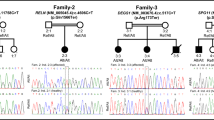Abstract
Infantile-onset ascending spastic paralysis (OMIM #607225) is a rare autosomal recessive early onset motor neuron disease caused by mutations in the gene ALS2. We report on a splice acceptor site mutation in intron 9 of ALS2 (IVS9–2A>T) in a German patient from nonconsanguineous parents. The mutation results in skipping of exon 10. This causes a frame-shift in exon 11 and a premature stop codon. Analysis of the parental ALS2 gene revealed heterozygosity for the mutation in the mother but not in the father. Therefore, we studied polymorphic markers scattered along chromosome 2 in both parents and the patient and found maternal uniparental disomy in the patient. While homozygosity was observed at several loci of chromosome 2 including ALS2, other loci were heterozygous, i.e., both maternal alleles were present. The findings can be explained by at least four recombination events during maternal meiosis followed by a meiosis I error and postzygotic trisomy rescue or gamete complementation.



Similar content being viewed by others
References
Pringle CE, Hudson AJ, Munoz DG, Kiernan JA, Brown WF, Ebers GC (1992) Primary lateral sclerosis, clinical features, neuropathology and diagnostic criteria. Brain 115:144–145 doi:10.1093/brain/115.2.495
Lesca G, Eymard-Pierre E, Santorelli FM, Cusmai R, di Capua M, Valente EM et al (2003) Infantile ascending hereditary spastic paralysis (IAHSP): clinical features in 11 families. Neurology 60:674–682
Hadano S, Hand CK, Osuga H, Yanagisawa Y, Otomo A, Devon RS et al (2001) A gene encoding a putative GTPase regulator is mutated in familial amyotrophic lateral sclerosis 2. Nat Genet 29:166–173 doi:10.1038/ng1001-166
Yang Y, Hentati A, Deng HX, Dabbagh O, Sasaki T, Hirano M et al (2001) The gene encoding alsin, a protein with three guanine-nucleotide exchange factor domains, is mutated in a form of recessive amyotrophic lateral sclerosis. Nat Genet 29:160–165 doi:10.1038/ng1001-160
Eymard-Pierre E, Lesca G, Dollet S, Santorelli FM, di Capua M, Bertini E (2002) Infantile-onset ascending hereditary spastic paralysis is associated with mutations in the alsin gene. Am J Hum Genet 71:518–527 doi:10.1086/342359
Verschuuren-Bemelmans CC, Winter P, Sival DA, Elting JW, Brouwer OF, Müller U (2008) Novel homozygous ALS2 nonsense mutation (p.Gln715X) in sibs with infantile-onset ascending spastic paralysis: the first cases from northwestern Europe. Eur J Hum Genet doi:10.1038/ejhg.2008.108
Sztriha L, Panzeri C, Kálmánchey R, Szabó N, Endreffy E, Túri S et al (2008) First case of compound heterozygosity in ALS2 gene in infantile-onset ascending spastic paralysis with bulbar involvement. Clin Genet 73:591–593
Otomo A, Hadano S, Okada T, Mizumura H, Kunita R, Nishijima H et al (2003) ALS2, a novel guanine nucleotide exchange factor for the small GTPase Rab5, is implicated in endosomal dynamics. Hum Mol Genet 12:1671–1687 doi:10.1093/hmg/ddg184
Hadano S, Kunita R, Otomo A, Suzuki-Utsunomiya K, Ikeda JE (2007) Molecular and cellular function of ALS2/alsin: implication of membrane dynamics in neuronal development and degeneration. Neurochem Int 51:74–84 doi:10.1016/j.neuint.2007.04.010
Rivolta C, Berson EL, Dryja TP (2002) Paternal uniparental heterodisomy with partial isodisomy of chromosome 1 in a patient with retinitis pigmentosa without hearing loss and a missense mutation in the Usher syndrome type II gene USH2A. Arch Ophthalmol 120:1566–1571
Webb AL, Sturgiss S, Warwicker P, Robson SC, Goodship JA, Wolstenholme J (1996) Maternal uniparental disomy for chromosome 2 in association with confined placental mosaicism for trisomy 2 and severe intrauterine growth retardation. Prenat Diagn 16:958–962 doi:10.1002/(SICI)1097-0223(199610)16:10<958::AID-PD971>3.0.CO;2-U
Hansen WF, Bernard LE, Langlois S, Rao KW, Chescheir NC, Aylsworth AS et al (1997) Maternal uniparental disomy of chromosome 2 and confined placental mosaicism for trisomy 2 in a fetus with intrauterine growth restriction, hypospadias, and oligohydramnios. Prenat Diagn 17:443–450 doi:10.1002/(SICI)1097-0223(199705)17:5<443::AID-PD82>3.0.CO;2-2
Petit FM, Gajdos V, Parisot F, Capel L, Aboura A, Lachaux A (2005) Paternal isodisomy for chromosome 2 as the cause of Crigler-Najjar type I syndrome. Eur J Hum Genet 13:278–282 doi:10.1038/sj.ejhg.5201342
Thompson DA, McHenry CL, Li Y, Richards JE, Othman MI, Schwinger E et al (2002) Retinal dystrophy due to paternal isodisomy for chromosome 1 or chromosome 2, with homoallelism for mutations in RPE65 of MERTK, respectively. Am J Hum Genet 70:224–229 doi:10.1086/338455
Chávez B, Valdez E, Vilchis F (2008) Uniparental disomy in steroid 5α-reductase 2 deficiency. J Clin Endocrinol Metab 85:3147–3150 doi:10.1210/jc.85.9.3147
Spiekerkoetter U, Eeds A, Yue Z, Haines J, Strauss AW, Summar M (2002) Uniparental disomy of chromosome 2 resulting in lethal trifunctional protein deficiency due tu homozygous α-subunit mutations. Hum Mutat 20:447–451 doi:10.1002/humu.10142
Heide E, Heide KG, Rodewald A (2000) Maternal uniparental disomy (UPD) for chromosome 2 discovered by exclusion of paternity. Am J Med Genet 92:260–263 doi:10.1002/(SICI)1096-8628(20000605)92:4<260::AID-AJMG7>3.0.CO;2-#
Kotzot D, Lurie I, Méhes K, Werder E, Schinzel A (2000) No evidence of uniparental disomy 2, 6, 14, 16, 20, and 22 as a major cause of intrauterine growth retardation. Clin Genet 58:177–180 doi:10.1034/j.1399-0004.2000.580304.x
Luedi PP, Dietrich FS, Weidman JR, Bosko JM, Jirtle RL, Hartemink AJ (2007) Computational and experimental identification of novel human imprinted genes. Genome Res 17:1723–1730 doi:10.1101/gr.6584707
Acknowledgment
We thank Dr. Dagmar Nolte for discussions.
Author information
Authors and Affiliations
Corresponding author
Additional information
Thilo Herzfeld and Nicole Wolf contributed equally to this paper.
Rights and permissions
About this article
Cite this article
Herzfeld, T., Wolf, N., Winter, P. et al. Maternal uniparental heterodisomy with partial isodisomy of a chromosome 2 carrying a splice acceptor site mutation (IVS9–2A>T) in ALS2 causes infantile-onset ascending spastic paralysis (IAHSP). Neurogenetics 10, 59–64 (2009). https://doi.org/10.1007/s10048-008-0148-y
Received:
Accepted:
Published:
Issue Date:
DOI: https://doi.org/10.1007/s10048-008-0148-y




